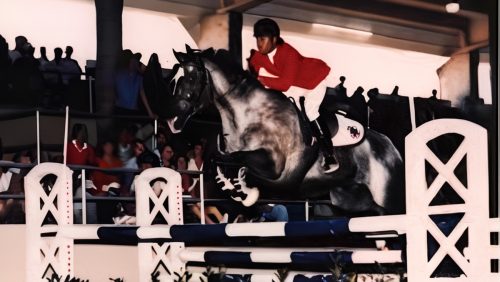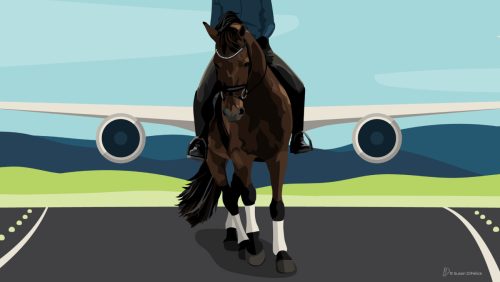Ever seen the Christopher Guest mockumentary “Best In Show?” It’s a hilarious film that everyone should watch. But I particularly prescribe it to people who don’t know much about the horse business, because if you were to switch terriers for Trakehners, hounds for Hanoverians, you’d get a pretty smashing look at all of the caricatures present in our weird little world.
Which is not to say that everyone in horses is weird. Well, actually, yeah, that’s true, but not everyone is quite THAT weird. But there are definitely some strong characters in the sport, and under the pressure of competition, or the pressure to make a buck, perfectly reasonable people can become not-so-easy to work with. And even with the best of people, the kind we’d all kill to ride for, who handle pressure brilliantly, it’s still an emotional ride.
Which brings me to Dressageonomics 301: Ownership, or Owners?
As a professional, there are two ways to compete. One is to ride horses you own – like the amateurs we teach and train – and the other is to ride someone else’s horses. There are pros and cons to both.
Let’s say you want to ride for an owner. First, you need to find one. And they’re not exactly plentiful. To get the support of the kind of patron who will drop big bucks on a finished horse for you, you have to have a pretty awe-inspiring résumé. There are lots of people out there who need horses ridden to get them sold, but those kinds of relationships are short – you don’t get to have the years it takes to develop a horse to FEI. You have the one or two horse shows to build its record up, and then someone comes along and buys the horse. Done deal.
So let’s say you find an owner who wants to support you with a young or in-development horse and give you the ride for a few years. But to what end? Sales are still often the light at the end of that tunnel, which can be financially lucrative for you – a 10 percent commission on a nice horse can be a big boost. But to get the big bucks, you usually have to sell the horse just as it’s reaching its peak. You never get to ride the crest of that wave.
Even if a sale isn’t the ultimate goal, you still have the risk that, at any moment, the horse could be taken away from you, sold or given to another rider to campaign. There are no guarantees, and we all know riders who’ve lost their mounts at the Eleventh Hour.
ADVERTISEMENT
And there’s always the management of expectations. I know so many wonderful owners, who support their riders, and who listen to their riders when the riders feel a change of pace or direction is needed. But there are also the barn-blind, the ones who can’t understand why their precious Poopsie isn’t winning all the time, the ones who demand a great deal of the riders’ time, the ones who want to push on when they should back off, or back off when the horse needs to be pushed. Sometimes there’s too many cooks in the kitchen, and there’s a lot of emotion involved.
But there are some major upsides, too. You don’t have to buy the horse. You don’t have to take the risk of the horse breaking a leg or colicking or never meeting expectations. Sometimes, riders even get paid in board and training to show someone else’s horse.
When you own your own horses, you never have the risk that someone will zoom them from you. But the risks are massive. How much do top FEI horses cost? To get a competitive Small Tour level horse young enough to advance to Grand Prix, a six-figure price tag is to be expected. A finished Grand Prix horse could be mid to high six, even low seven, depending on its international experience and team potential. That’s just plain out of reach for the mere mortal dressage trainer.
Let’s say that you go get a nice 2-year-old like my Fairvoya, who is currently priced at $25,000. Do you keep her at home? Foals and young horses flourish when raised with other young horses. If you have a herd you can stick them in, great. But if not, you’re looking at boarding them somewhere with a foal raising program. (Mine live in the superlative care of Jenni Coyle Johnson at her JC Andalusians, in Barboursville, who deserves this shout-out for all the awesomeness she’s done for the three amigos. Thanks, Jenni!)
If you are skilled in starting youngsters, you can do it yourself. If, like me, you hate it, you can send it to someone like my buddies Renee Carter or Eliza Sydnor, who are exceptional starters. And at late-3, early-4, you have yourself something to ride…
At Training Level. Maybe First.
You’re looking at 5 or 6 years, easy, of vet bills, farrier bills, dentist bills. Saddle fitters and acupuncturists. Show fees and lessons. And this is all assuming nothing goes wrong, before the creature gets to Grand Prix. And then there’s the chance that it doesn’t get to Grand Prix at all. Hopefully you’ve done a fine enough job to make the horse a salable one, but there’s no guarantee of that either.
ADVERTISEMENT
And remember that “assuming nothing goes wrong?” Stuff goes wrong all the time. Where’s Cleo right now, after a career-ender sustained right at the end of her first season at Grand Prix? An expensive lawn ornament. Thanks be to the heavens above for my aunt Jane, who added Cleo to her herd of retirees, saving me the decision of whether to keep her at home or pay for her to be boarded somewhere else to free up a stall at my place. Neither option would have been fun.
The wise rider, professional or amateur, dressage or something else, insures their horses. But where mortality is easy, “loss of use” is not. How do you prove such a claim? What if there’s a chance of recovery – even an infinitesimal one – but it could be years down the line? It’s a tricky business, if your horse becomes injured, but not fatally so.
Amateur or professional, once you get that horse to the upper levels, you’re looking at all the expenses of campaigning it, which are colossal, as I’ve already bored you all with. But I think it’s safe to say that an average cost of getting a horse from 2 years old and unstarted to 10 years old at Grand Prix would be a six-figure number. And more than that wouldn’t be unheard of.
So what can we do, we professionals who haven’t had luck attracting patrons? Some of us will get horses off the track, or from troubled situations, and put a few months or a year in and “flip” them, working our ways up to better quality horses.
Our eventer brethren have taken up the banner of a clever solution – syndication. Check out www.experienceeventing.com, a website linking those who are seeking owners to ride for, either for the future or for a horse already in their care, with those who want to participate in horse ownership, but as part of a group, therefore only bearing a fraction of the cost.
Mostly, we work hard. We keep our heads down, ride everything that comes our way, do right by our people and our animals, and make our own luck.















